Theoretical study for Laser Lines in Carbon like Zn (XXV)
Volume 6, Issue 4, Page No 334-340, 2021
Author’s Name: Nahed Hosny Wahba1,a), Wessameldin Salah Abdelaziz1, Tharwat Mahmoud Alshirbeni2
View Affiliations
1Department of Laser Applications in Metrology, Photochemistry, and Agriculture, National Institute of Laser Enhanced Sciences, Cairo University, Giza, 12613, Egypt
2Physics Department, Faculty of Science, Cairo University, Giza 12613, Egypt
a)Author to whom correspondence should be addressed. E-mail: nahedwahba77@gmail.com
Adv. Sci. Technol. Eng. Syst. J. 6(4), 334-340 (2021); ![]() DOI: 10.25046/aj060437
DOI: 10.25046/aj060437
Keywords: FAC, C-like Zn (XXV), Coupled Rate Equation, Reduced Population, Radiative Decay, Doppler Broadening Equation, Gain Coefficient
Export Citations
The energy states, transitions chances, oscillator intensities, and collision intensities were computed with FAC (fully relativistic flexible atomic code) program. The calculated results were utilized for identification of the reduced population to sixty-nine thin structural states in C-like Zn (XXV) and indicates the gain coefficients with several electron densities (from 10+20 to 10+22 cm3) and at a wide range of electron plasma temperatures (700,800,900,1000, &1100,1200,1300,1400,1500) eV. By using coupled rate equation to calculate the reduced population at different temperature and plotting that against electron densities; gives that at lower electron densities the reduced population proportional with reduced population till radiative decay happening; while at higher electron densities than 10+20 the radiative decay may be neglected in comparing with collisional depopulation so population states becomes independent and approximately the same. The gain coefficient was calculated by using the Doppler broadening equation of several transitions in Zn(XXV); these data plotted against electron density, and it was found that the gain was increased with temperature and producing the short wavelength laser , between 22 and 50 nm for the Zn30+ion. The data was compared with the experimental calculations values collected by NIST and with the theoretical calculations of Bhatia, Seely&Feldman; where the calculated data differs from energy levels of Zn (XXV) comparing to experimental values in NIST at (2p1/2 2p3/2)1 and (2p1/2 2p3/2)2 by 0.05 and 0.04 successively; and it differs than the theoretical work of Bhatia at (2p1/2 2p3/2)1 and (2p1/2 2p3/2)2 by 0.05 Ryd and 0.04 Ryd successively also; which proved that our calculations are in well agreement with other works.
Received: 06 July 2021, Accepted: 08 August 2021, Published Online: 16 August 2021
1. Introduction
X-ray lasers are a class of lasers in which gain has been demonstrated over various discrete wavelengths ranging from 3.56nm to 46.9nm. Because of the very short-duration and high-energy excitation pulses required to generate these lasers [1], [2], photo excitation method [3], Electron collisional pumping method (ECP), charge transfer technique, electron collisional recombination process and dielectronic recombination pumping are examples of X-ray pumping procedures which using picoseconds chirped pulse amplification (CPA) pulses [4]-[6]. Globally it’s often observed that carbon is abundant element in astrophysical sits having the atmosphere. Emission lines of C-like ions are functionalized at prosopopoeia of the solar, astrophysical and melting plasmas whose illustrating needed exact atomic calculations; where the soft X-ray and XUV regions most of the data was found[7], [8]; thus Electron Collisional Pumping was functionalized to generate soft X-ray lasers after pumping methods[9], [10].
The process of pumping was illustrated as following:
Xln+ + e Xun+
where Xln+ is a n-frequencies of atom ionization of the element X that pumping occurrence from lower level “l” to an excited level “u” in the same element atoms.
Theoretically there are more works done for computing the energy states, transition possibilities’ and oscillator powers for Zn (XXV) [11]-[17]; while the gain for the same element not have more studies. The goal of this thesis is to utilize the atomic calculations such as energy states, oscillator powers and spontaneous radiative decay rates which calculated by using (FAC) program depending on Dirac equation for sixty nine thin-structure states to compute reduced populations and gain coefficients of C-like Zn excited states through a broad extent of electron densities (10+20 to10+23) and at several electron temperatures (700, 800, 900, 1000, 1100, 1200, 1300, 1400 & 1500).These calculations might support the experimentalists for generating soft X-ray lasers.
- Calculations equations used for Gain Coefficient determination
To calculate gain coefficient firstly energy levels, weighted oscillator strength and radiative rate for allowed transitions should be calculated; then the reduced population should calculated by solving coupled rate equation [18], [19]. After calculating the reduced population, it used to solve the Doppler broadening equation to obtain the gain coefficient.
Laser emission from Zn (XXV) ions plasma was investigated by studying the relation between several plasma temperatures and electron densities.
According to equation (1)
 Since and are the fractional populations of levels successively, represents Einstein coefficient for spontaneous radiative decay from u to l; represents the electron density and are the rate coefficients for collisional excitation and de-excitation successively. The actual population density of the state can be computed from relation (2) [20][21].
Since and are the fractional populations of levels successively, represents Einstein coefficient for spontaneous radiative decay from u to l; represents the electron density and are the rate coefficients for collisional excitation and de-excitation successively. The actual population density of the state can be computed from relation (2) [20][21].
 Since and represents a statistical weights of lower and upper states, successively.
Since and represents a statistical weights of lower and upper states, successively.
The electron impact excitation rates identified by the effective collision strengths
[20]Where;
 The measured population density of the was calculated [20],
The measured population density of the was calculated [20],
![]() Since is the number of ions which achieved at the ionization stage [20],
Since is the number of ions which achieved at the ionization stage [20],
![]() Since is the electron density, is the average degree of ionization and is the fractional abundance of the ionization levels were calculated [20]. Where the populations computed from Equation (1) is equal the unit;
Since is the electron density, is the average degree of ionization and is the fractional abundance of the ionization levels were calculated [20]. Where the populations computed from Equation (1) is equal the unit;
 where the populations density calculated by Equation (1) is equal unit,
where the populations density calculated by Equation (1) is equal unit,
By computation the state’s population density, the values and can be determined.
To prove that when inversion factor (F<0) gives positive gain equation (7) was used[22];
![]() Since and are the reduced populations of the upper state and lower state successively. Then Eq. (7) used to compute the gain coefficient (α) for Doppler broadening of the various transitions in the Zn (XXV) ion.
Since and are the reduced populations of the upper state and lower state successively. Then Eq. (7) used to compute the gain coefficient (α) for Doppler broadening of the various transitions in the Zn (XXV) ion.
![]() Since M is the ion mass, is the transition wavelength in (nm), and is the ion temperature in eV.
Since M is the ion mass, is the transition wavelength in (nm), and is the ion temperature in eV.
- Results and discussions
3.1. Energy states
With utilizing (FAC) [23] energy state measures for the 1s2 2s2 2pnl (n=3, l=s, p & d) and ml (m=4,l=s, p, d &f ) configurations in C-like Zn+30 was obtained, this data presented in Tables (1); which shows the 69 energy levels of transition configurations:
Table (2) presented the comparison between our calculations of energy levels for Zn (XXV) the theoretical calculations by Bhatia, Seely and Feldman [12] and the actual results computed by NIST [24].
In table (2), the calculated data for energy levels of Zn (XXV) comparing to experimental values in NIST at (2p1/2 2p3/2)1 and (2p1/2 2p3/2)2 by 0.05 and 0.04 successively; and it differs than the theoretical work of Bhatia at (2p1/2 2p3/2)1 and (2p1/2 2p3/2)2 by 0.05 Ryd and 0.04 Ryd successively also; which proved that our calculations are in well agreement with other works.
3.2. Level population
Where increasing the excited electrons in higher energy states than in ground state causes the production of Laser in the XUV and soft X-ray spectral area;
Table 1: Energy states and definitions for Zn (XXV)
Schematic diagram of population inversion (Source of figure: https://spie.org/publications/fg08_p94_lasers?SSO=1)
Table 2: The comparison between our calculations of energy levels
 Note: (a) present thesis results calculated by (FAC), (b) S.S data is the work done by Bhatia et al. & (c) NIST data.
Note: (a) present thesis results calculated by (FAC), (b) S.S data is the work done by Bhatia et al. & (c) NIST data.
Thus the process of the reduced population densities was computed for sixty nine thin structure states starting from 1s2 2s2 2pnl (n=3, l=s, p&d) and ml (m=4, l=s, p, d &f) configurations. The determination was done by applying the coupled rate Eq. (1) simultaneously using MATLAB version 7.10.0 (R2010a) computer program [25][17].
Figure (1 to 4) illustrate the reduced population for states (2p3/23s1/2)2, (2p1/23p3/2)1, (2p3/23p3/2)3, (2p3/23p3/2)1, (2p3/23d5/2)4, and (2p3/23d3/2)3at various temperatures (800,900,1000,1100)eV; so it can explain the behavior of states populations’ density for several ions; where at low electron densities the reduced population densities are proportional to the electron densities, and the excitation process for an excited state is followed immediately by radiation decay. These results were agreed with the results of Feldman et.al. [11,17,24]. At electron density 10+19 various peaks were appeared; which means that radiative transitions dominant the de-excitation due its higher energy and fast decay time.
 Figure 1: Reduced population of Zn+30 states at electron temperature 800eV.
Figure 1: Reduced population of Zn+30 states at electron temperature 800eV.
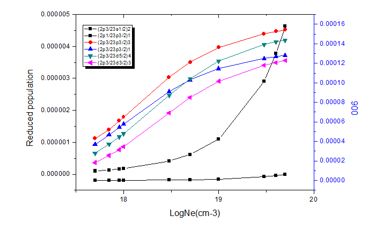 Figure 2: Reduced population of Zn+30 states at electron temperature 900eV.
Figure 2: Reduced population of Zn+30 states at electron temperature 900eV.
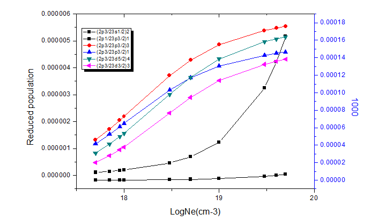 Figure 3: Reduced population of Zn+30 states at electron temperature 1000eV.
Figure 3: Reduced population of Zn+30 states at electron temperature 1000eV.
Let the population of energy El be Nl and the population of energy Eu be Nu. The energy between the ground state Eu and excited state El is a photon with energy (Eu-El) is required to stimulated the transition; however, by using optical pumping electrons from ground state which jumping to excited state by absorbing photons. The stimulated emission and absorption probabilities` per occupied state are the same, therefore we must have a mechanism where Nu > Nl. The reduced populations’ density were computed as a function of electron density then drawn at different plasma temperatures for Zn (XXV) ion. Figure (5, 6) illustrate (2p1\23p1\2)1, and (2p1\23p3\2)1 states for Zn (XXV) were studied at temperatures (700, 800, 900, 1000, 1100, 1200, 1300, 1400&1500) eV.
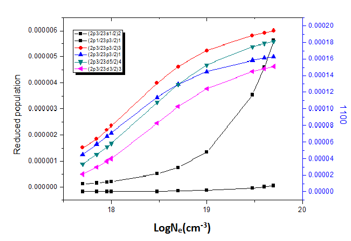 Figure 4: Reduced population of Zn+30 states at electron temperature 1100eV.
Figure 4: Reduced population of Zn+30 states at electron temperature 1100eV.
 Figure 5: Reduced population of level (a) (2p1\23p1\2)1, (b) (2p1\23p3\2)1 for Zn (XXV) after electron collisional pumping as a function of the electron density at temperatures (700, 800, 900, 1000, 1100, 1200, 1300, 1400&1500) eV.
Figure 5: Reduced population of level (a) (2p1\23p1\2)1, (b) (2p1\23p3\2)1 for Zn (XXV) after electron collisional pumping as a function of the electron density at temperatures (700, 800, 900, 1000, 1100, 1200, 1300, 1400&1500) eV.
3.3. Radiative lifetime
During the excitation process the electrons transferred from ground state to excited population states, after time electron transition reversed through the depopulation process; the time of reversing the transition in the inverse process called radiative life time. The radiation process of X-ray depending on stimulated emission of radiation from upper to lower states; then using these transition to calculate the life time. By using equation (9) the atomic transfer probability is related to the life time u of an exited state
 Figure 6: Reduced population of level (a) (2p3\23p3\2)3, (b) (2p3\23p3\2)1 for Zn (XXV) as a function of the electron density at different electron temperatures (700,800, 900, 1000, 1100, 1200, 1300, 1400&1500) eV.
Figure 6: Reduced population of level (a) (2p3\23p3\2)3, (b) (2p3\23p3\2)1 for Zn (XXV) as a function of the electron density at different electron temperatures (700,800, 900, 1000, 1100, 1200, 1300, 1400&1500) eV.
 Table 3. Illustrate the results of (2p1/23d3/2)2–(2p1/23p3/2)1, (2p3/23d5/2)4—(2p1/23p3/2)1and (2p3/23d5/2)4—((2p1/23p3/2)2radiative life time is longer than the lifetime of the lower state.
Table 3. Illustrate the results of (2p1/23d3/2)2–(2p1/23p3/2)1, (2p3/23d5/2)4—(2p1/23p3/2)1and (2p3/23d5/2)4—((2p1/23p3/2)2radiative life time is longer than the lifetime of the lower state.
Table 3. Radiative lifetime for Zn30+ laser levels
According to equation (7) the reduced population for lower states and upper states was calculated and demonstrate in the equation to calculate the inversion factor and it’s found that the inversion factor is larger than zero. By using electron collisional pumping process the pumping quanta can be transferred to other state as a result of collision process, and this cause population inversion from the upper states to the lower states; whence this population inversion achieved appositive gain via F<0[21].
3.5. Gain coefficient
The gain process is the measure of the part of medium energy transferred to the emitted radiation which causes the amplification of the emitted radiation leading to strength optical power.
To calculate the gain the MATlab version the program was used to solve the coupled rate equation; this by using Aul (spontaneous decay rates), Celu (electron collisional excitation rate coefficients) and Cdul (electron collisional deexcitation rate coefficients).
This data is computed by MATlab to solve coupled rate equation to calculate the population inversion; then calculating the inversion factor which F< 0.
Finally the Doppler broadening equation was solved for various transitions to give the gain coefficient; then by plotting the relation between gain and electron density at different temperature to obtain the most intense laser transitions.
The figures (7, 8, 9, 10 & 11) illustrates the proportional relation between gain and electron density; and also have proportional relation between gain and temperature. According to the collected data it’s found that the largest gain occur at temperature (1100eV) which give gain height of (13.522cm-1) at wavelength (50nm); this transition is at (2p3/23p3/2)1—(2p1/23p3/2)1 which refers to them by (16<>9). The smallest gain occur at temperature (800eV) which give gain height of (2.5530cm-1) at wavelength (22.79nm); this gain transition at (2p3/23d5/2)4—(2p1/23p3/2)1which describe them as (22<>10); the gain of these transition at (22<>10) and at (16<>9) was plotted against electron densities at different temperatures. See Figure (11).
 Figure 7: Electron density versus Gain coefficient at temperature 800 eV.
Figure 7: Electron density versus Gain coefficient at temperature 800 eV.
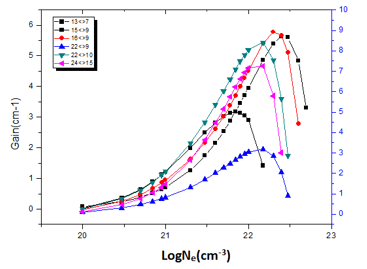 Figure 8: Electron density versus Gain coefficient at temperature 900 eV.
Figure 8: Electron density versus Gain coefficient at temperature 900 eV.
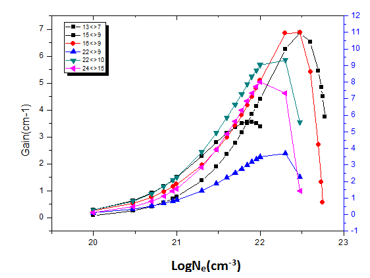 Figure 9: Electron density versus Gain coefficient at temperature1000 eV.
Figure 9: Electron density versus Gain coefficient at temperature1000 eV.
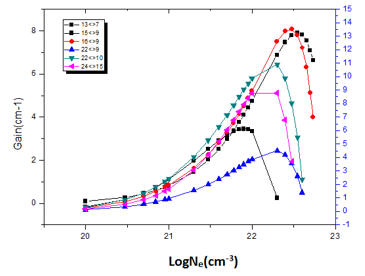 Figure 10: Electron density versus Gain coefficient at temperature1100 eV.
Figure 10: Electron density versus Gain coefficient at temperature1100 eV.
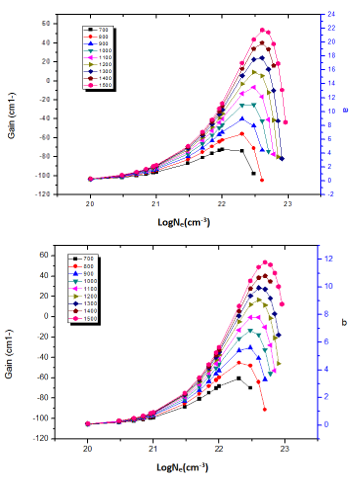 Figure 11: Gain coefficient for (a) (2p3/23p3/2)1—(2p1/23p3/2)1 and (b) (2p3/23p3/2)3—(2p1/23p1/2)1 transitions against electron density (Ne) at different electron temperature.
Figure 11: Gain coefficient for (a) (2p3/23p3/2)1—(2p1/23p3/2)1 and (b) (2p3/23p3/2)3—(2p1/23p1/2)1 transitions against electron density (Ne) at different electron temperature.
Table 4: configuration states, wavelength and maximum gain coefficient at various temperatures.
The electron collisional pumping is appropriate for achieving population inversion. The comparison of present thesis data with the previous experimental calculated data by NIST and with the theoretical calculated data by Bhatia,Seely&Feldman was illustrated that energy levels of Zn (XXV) differs than experimental values of NIST at (2p1/2 2p3/2)1 and (2p1/2 2p3/2)2 by 0.05 and 0.04 successively; and differs than the theoretical work of Bhatia at (2p1/2 2p3/2)1 and (2p1/2 2p3/2)2 by 0.05 Ryd and 0.04 Ryd successively also; which proved that our calculations are in well agreement with other works. The results gave spectral region between 22 and 50 nm in the XUV region for the Zn30+ion.
Conflict of Interest
The authors declare no conflict of interest.
Acknowledgment
The authors thanks both Prof. Dr. Souad ElFeky, Dr. Nagy Emara, and NILES their promotion and support.
- W..T. Silfvast, Cambridge University press, second edi, 2000.
- B.N. Wellegehausen, B., Eichmann, H., Meyer, S., Momma, C., Mossavi, K., Welling, H., &Chichkov, “Generation of coherent VUV and XUV radiation. In ICONO’95: Fundamentals of Laser-Matter Interaction.,” International Society for Optics and Photonics., 2796, 132–139, 1996.
- A. Verma, R. Kumar, A. Parashar, “Enhanced thermal transport across a bi-crystalline graphene–polymer interface: an atomistic approach,” Physical Chemistry Chemical Physics, 21(11), 6229–6237, 2019.
- R.E. King, G.J. Pert, S.P. McCabe, P.A. Simms, A.G. MacPhee, C.L.S. Lewis, R. Keenan, R.M.N. O’Rourke, G.J. Tallents, S.J. Pestehe, “Saturated x-ray lasers at 196 and 73 Å pumped by a picosecond traveling-wave excitation,” Physical Review A, 64(5), 53810, 2001.
- A. V Vinogradov, I.I. Sobel’man, E.A. Yukov, “Population inversion of transitions in neon-like ions,” Soviet Journal of Quantum Electronics, 7(1), 32, 1977.
- B.A. Norton, N.J. Peacock, “Population inversion in laser-produced plasmas by pumping with opacity-broadened lines,” Journal of Physics B: Atomic and Molecular Physics, 8(6), 989, 1975.
- G. Tachiev, C.F. Fischer, “Breit-Pauli energy levels and transition rates for the carbonlike sequence,” Canadian Journal of Physics, 79(7), 955–976, 2001.
- K.M. Aggarwal, F.P. Keenan, A.Z. Msezane, “Oscillator strengths for transitions in C-like ions between K XIV and Mn XX,” Astronomy & Astrophysics, 401(1), 377–383, 2003.
- V.A. Bhagavatula, “Soft x?ray population inversion by resonant photoexcitation in multicomponent laser plasmas,” Journal of Applied Physics, 47(10), 4535–4537, 1976.
- J. Nilsen, P. Beiersdorfer, S.R. Elliott, T.W. Phillips, B.A. Bryunetkin, V.M. Dyakin, T.A. Pikuz, A.Y. Faenov, S.A. Pikuz, S. Von Goeler, “Measurement of the Ly-? Mg resonance with the 2s? 3p Ne-like Ge line,” Physical Review A, 50(3), 2143, 1994.
- U. Feldman, G.A. Doschek, J.F. Seely, A.K. Bhatia, “Short wavelength laser calculations for electron pumping in Be I and BI isoelectronic sequences (18? Z? 36),” Journal of Applied Physics, 58(8), 2909–2915, 1985.
- A.K. Bhatia, J.F. Seely, U. Feldman, “Atomic data and spectral line intensities for the carbon isoelectronic sequence (Ar XIII through Kr XXXI),” Atomic Data and Nuclear Data Tables, 36(3), 453–494, 1987, doi:https://doi.org/10.1016/0092-640X(87)90012-X.
- A. Verma, A. Parashar, “Molecular dynamics based simulations to study the fracture strength of monolayer graphene oxide,” Nanotechnology, 29(11), 115706, 2018, doi:10.1088/1361-6528/aaa8bb.
- A. Verma, A. Parashar, “Molecular dynamics based simulations to study failure morphology of hydroxyl and epoxide functionalised graphene,” Computational Materials Science, 143, 15–26, 2018.
- V. Singla, A. Verma, A. Parashar, “A molecular dynamics based study to estimate the point defects formation energies in graphene containing STW defects,” Materials Research Express, 6(1), 15606, 2018.
- A. Verma, A. Parashar, M. Packirisamy, “Atomistic modeling of graphene/hexagonal boron nitride polymer nanocomposites: a review,” Wiley Interdisciplinary Reviews: Computational Molecular Science, 8(3), e1346, 2018.
- U. Feldman, J.F. Seely, G.A. Doschek, A.K. Bhatia, “3 s–3 p laser gain and x?ray line ratios for the carbon isoelectronic sequence,” Journal of Applied Physics, 59(12), 3953–3957, 1986.
- U. Feldman, A.K. Bhatia, S. Suckewer, “Short wavelength laser calculations for electron pumping in neon?like krypton (Kr XXVII),” Journal of Applied Physics, 54(5), 2188–2197, 1983.
- U. Feldman, J.F. Seely, A.K. Bhatia, “Scaling of collisionally pumped 3 s?3 p lasers in the neon isoelectronic sequence,” Journal of Applied Physics, 56(9), 2475–2478, 1984.
- W.H. Goldstein, J. Oreg, A. Zigler, A. Bar-Shalom, M. Klapisch, “Gain predictions for nickel-like gadolinium from a 181-level multiconfigurational distorted-wave collisional-radiative model,” Physical Review A, 38(4), 1797, 1988.
- A. V Vinogradov, V.N. Shlyaptsev, “Calculations of population inversion due to transitions in multiply charged neon-like ions in the 200–2000 Å range,” Soviet Journal of Quantum Electronics, 10(6), 754, 1980.
- I.I.S. Man, Introduction to the theory of atomic spectra, International series of Monographs in Natural Philosophy, Vol. (40), Pergamon Press.
- [FAC Code. http://kipac-tree.stanford.edu/fac].
- NIST [http:///F:/NIST/NIST%20ASD%20Levels%20Output32.htm].
- R.D. Neidinger, “Introduction to automatic differentiation and MATLAB object-oriented programming,” SIAM Review, 52(3), 545–563, 2010.
Citations by Dimensions
Citations by PlumX
Google Scholar
Crossref Citations
No. of Downloads Per Month
No. of Downloads Per Country



